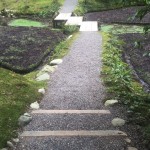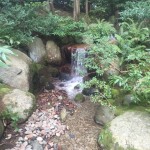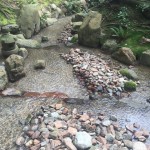I visited the Nitobe Garden last week, and the use of water and stone in the garden stood out to me. The Nitobe Garden was a Chisen style garden, and it had Chisen kaiyuu elements in it (Sugiyama, The Conventions of Japanese Gardens). Water was an important part of Nitobe Garden, as there was a floating stream, a dropping waterfall, and a reflecting pond in the garden. The movements of the water provided contrasting sounds and sceneries, which gave the visitors of the garden vivid and unique impressions. The floating stream moved slowly and quietly, with twists, turns, and drops along the way. The water in the stream was so clear and shallow that I felt my soul and mind were cleansed by the water. The sound of the waterfall was musical, which made the garden livelier, and the reflecting pond was relaxing and serene to look at.
Stone arrangements were also a key element in Nitobe Garden. There were stone arrangements along pathways in the garden, and rocks and stones were used in and around waters in the garden. The stones and rocks added texture to the garden, and the hardness of the stones created contrast with the softness presented by the water. There were several beautiful stone lanterns in the garden, and as Ryo stated that the stone lanterns were “to symbolically light pathway” and “to cast a beam of light across water”, these lanterns were symbolically important.
Reference
Sugiyama, Ryo. The Conventions of Japanese Gardens. Class PDF handout.




